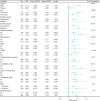Association Between Metabolic Score for Insulin Resistance (METS-IR) and Risk of Obstructive Sleep Apnea: Analysis of NHANES Database and a Chinese Cohort
- PMID: 40260090
- PMCID: PMC12011028
- DOI: 10.2147/NSS.S400125
Association Between Metabolic Score for Insulin Resistance (METS-IR) and Risk of Obstructive Sleep Apnea: Analysis of NHANES Database and a Chinese Cohort
Abstract
Purpose: Insulin resistance (IR) plays a significant role in the development of obstructive sleep apnea (OSA). The metabolic score for insulin resistance (METS-IR) is a novel method for assessing IR. This study aims to explore the relationship between METS-IR and the risk of OSA.
Patients and methods: This cross-sectional study included a total of 8297 subjects from NHANES (National Health and Nutrition Examination Survey) database, as well as 581 patients who underwent sleep monitoring in Renmin Hospital of Wuhan University. Logistic regression, subgroup analysis, and receiver operating characteristic (ROC) curve analysis were employed for evaluation.
Results: In the American population, a significant positive association was found between METS-IR and increased risk of OSA. For each unit increase in METS-IR, the risk of OSA increased by 4.4% (OR= 1.044; 95% CI: 1.037-1.059; P <0.001). A similar relationship was observed in the Chinese population. Multivariate Logistic regression model showed that for each unit increase in METS-IR, the prevalence of OSA increased by 6.7% (OR= 1.067; 95% CI: 1.035-1.103; P <0.001), and apnea-hypopnea index (AHI) increased by 0.732 (β= 0.732; 95% CI: 0.573-0.732; P <0.001). Gender subgroup analysis further showed that the association between METS-IR and OSA was particularly significant in male participants (OR= 1.111; 95% CI: 1.065-1.163; P <0.001). In the ROC analysis, the area under the curve (AUC) value of METS-IR for predicting OSA was 0.777, but it is not statistically significantly different from triglyceride glucose (TyG) (AUC = 0.749; P = 0.054), body mass index (BMI) (AUC = 0.769; P = 0.269), and triglyceride glucose-body mass index (TyG-BMI) (AUC = 0.777; P = 0.996).
Conclusion: METS-IR is significantly associated with the risk of OSA and may serve as an effective predictive marker for identifying OSA.
Keywords: Insulin resistance; cross-sectional study; metabolic score for insulin resistance; obstructive sleep apnea.
© 2025 Zhou et al.
Conflict of interest statement
The authors report no conflicts of interest in this work.
Figures



Similar articles
-
Association between METS-IR index and obstructive sleep apnea: evidence from NHANES.Sci Rep. 2025 Feb 24;15(1):6654. doi: 10.1038/s41598-024-84040-9. Sci Rep. 2025. PMID: 39994225 Free PMC article.
-
Comparison of the predictive value of TyG index and METS-IR for OSA combined with NAFLD: a retrospective observational study based on a physical examination population.BMC Gastroenterol. 2025 Apr 21;25(1):279. doi: 10.1186/s12876-025-03856-5. BMC Gastroenterol. 2025. PMID: 40259241 Free PMC article.
-
Non-linear association of the metabolic score for insulin resistance with obstructive sleep apnea: a cross-sectional study from NHANES 2015-2018.Front Nutr. 2025 Feb 26;12:1545140. doi: 10.3389/fnut.2025.1545140. eCollection 2025. Front Nutr. 2025. PMID: 40078414 Free PMC article.
-
Association between triglyceride glucose-body mass index and obstructive sleep apnea: a study from NHANES 2015-2018.Front Nutr. 2024 Aug 16;11:1424881. doi: 10.3389/fnut.2024.1424881. eCollection 2024. Front Nutr. 2024. PMID: 39221158 Free PMC article. Review.
-
Triglyceride-glucose index and obstructive sleep apnea: a systematic review and meta-analysis.Lipids Health Dis. 2024 Jan 8;23(1):4. doi: 10.1186/s12944-024-02005-3. Lipids Health Dis. 2024. PMID: 38185682 Free PMC article.
Cited by
-
Letter to the Editor Regarding: "Association between Metabolic Score for Insulin Resistance (METS-IR) and Risk of Obstructive Sleep Apnea: Analysis of NHANES Database and a Chinese Cohort" [Letter].Nat Sci Sleep. 2025 May 22;17:987-988. doi: 10.2147/NSS.S536885. eCollection 2025. Nat Sci Sleep. 2025. PMID: 40421424 Free PMC article. No abstract available.
References
LinkOut - more resources
Full Text Sources

